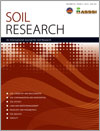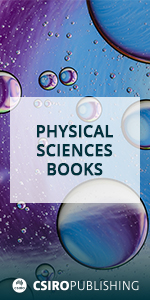Not all red soils are hardsetting, neither are all hardsetting soils red. Hardsetting soils can be detected by measuring the depth of soft soil 24 hours after irrigation or significant rain, but more elaborate methods can show differences due to short-term changes in management. Management of hardsetting soils must include the whole rotation, including when to till, when to crop, and when to graze or not.

Soil Research
Volume 50 Number 5 2012
SR12061Evaluation and modelling of furrow infiltration for uncropped ridge–furrow tillage in Loess Plateau soils
The soil water transport is a critical process for agricultural water supply on field. We found that wetted perimeter and bulk density were the effectual components of furrow infiltration. The Kostiakov-Lewis infiltration model incorporating wetted perimeter could effectively simulate soil water infiltration for uncropped ridge-furrow systems. The information obtained from this research is useful in designing irrigation schemes and field management for ridge–furrow tillage.
SR11200An investigation of runoff from raised beds and other tillage methods in the high rainfall zone of south-western Victoria, Australia
Little has been reported on the impact of raised beds on surface water flows from rain-fed cropping land in southern Australia. Because runoff from cropping land can have off-site impacts, this study compared runoff from raised beds with that from conventional and deep cultivation treatments on a sodic soil. During wet periods, raised beds significantly increased runoff due to the presence of furrows, while in drier seasons there was little difference in the runoff produced between the different cultivation treatments.
SR12101Shift in C and N humification during legume litter decomposition in an acid tropical Ferralsol
Legume-based crop systems play a key role in the management of soil fertility in the humid tropics. We show that the addition of legume litter of high quality increases soil nitrogen (N) more than soil carbon (C), due to a shift in N and C humification during litter decomposition. Modelling studies that do not account for such a shift could underestimate the positive effects of legume litter on N supply and on soil fertility in the humid tropics.
SR11247Soil series and land use impacts on major soil properties: A quantitative comparison
Human impact on soils has widespread implications for long term environmental sustainability. This study measured changes in multiple soil properties across three land use types (cropland, wetland reserve lands, and native forest) to determine the extent of human impacts via farming. Results showed that many soil properties can be significantly altered by humans; impacts which remain long after farming cessation and highlight the importance of proper land management and conservation.
SR12134Measuring organic carbon in Calcarosols: understanding the pitfalls and complications
The organic carbon (OC) content of a soil is a key indicator of its fertility status, but measurement of OC is difficult in soils that contain large quantities of carbonate (calcarosols). We compared the performance of variants of the two widely used approaches – wet oxidation and dry combustion with pre-treatment to remove carbonate – and found they gave different answers. The implication is that interpretation of organic C contents of calcarosols is complicated, no matter what technique is used.
SR12075Ash from the thermal gasification of pig manure—effects on ryegrass yield, element uptake, and soil properties
The thermal processing of pig manure is an efficient way to extract energy and nutrients. The resultant ash can be safely applied to acidic agricultural land to increase plant growth and phosphorus uptake and to reduce soil acidity. The ash will not be an effective fertiliser for alkaline soils.
SR11342Plant-available manganese in bauxite residue sand amended with compost and residue mud
Alleviating manganese deficiency in residue sand is a matter of concern in revegetating bauxite residue sand thus experiments were conducted to examine strategies to remedy this problem. Incubation of residue sand with organic and mineral amendments over a 30-day period found little change in DTPA-extractable Mn concentrations. The highest Mn concentrations were consistently associated with the carbonate fraction and hence overcoming Mn deficiency in vegetation on bauxite residue sand may depend on using Mn-efficient species which are able to efficiently extract Mn associated with carbonate and Fe / Al oxy-hydroxide fractions.
SR11312Characterising the chemistry of micropores in a sodic soil with strong texture-contrast using synchrotron X-ray techniques and LA-ICP-MS
This study focusses on answering the question, do the roots in hostile-sodic soils follow the old root pores only because they offer the less resistant pathway or are they chemically superior to the surrounding soil? Study revealed that some nutrient element accumulation around the old pores, while their chemical speciation does not seem changing with, about 10 mm, distance from the pore.
SR12013Short-term effects of organic waste amendments on soil biota: responses of soil food web under eggplant cultivation
We investigated how application of reusable organic materials influences soil ecosystem. We found that only microbial decomposers and secondary consumers were affected by the applications. Our study suggests that the effect of organic amendment may not extend to entire soil food-web in a short period.



